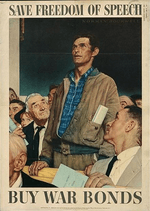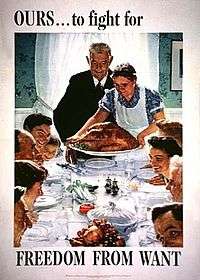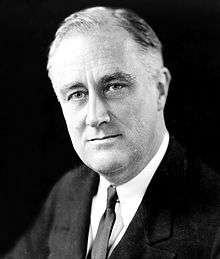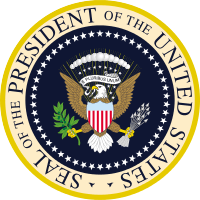Four Freedoms

The Four Freedoms were goals articulated by United States President Franklin D. Roosevelt on January 6, 1941. In an address known as the Four Freedoms speech (technically the 1941 State of the Union address), he proposed four fundamental freedoms that people "everywhere in the world" ought to enjoy:
Roosevelt delivered his speech 11 months before the United States declared war on Japan, December 8, 1941. The State of the Union speech before Congress was largely about the national security of the United States and the threat to other democracies from world war that was being waged across the continents in the eastern hemisphere. In the speech, he made a break with the tradition of United States non-interventionism that had long been held in the United States. He outlined the U.S. role in helping allies already engaged in warfare.
In that context, he summarized the values of democracy behind the bipartisan consensus on international involvement that existed at the time. A famous quote from the speech prefaces those values: "As men do not live by bread alone, they do not fight by armaments alone." In the second half of the speech, he lists the benefits of democracy, which include economic opportunity, employment, social security, and the promise of "adequate health care". The first two freedoms, of speech and religion, are protected by the First Amendment in the United States Constitution. His inclusion of the latter two freedoms went beyond the traditional Constitutional values protected by the U.S. Bill of Rights. Roosevelt endorsed a broader human right to economic security and anticipated what would become known decades later as the "human security" paradigm in social science and economic development. He also included the "freedom from fear" against national aggression and took it to the new United Nations he was setting up.
Historical context
With the end of World War I (1914–18), the United States adopted a policy of isolationism and non-interventionism, having refused to endorse the Versailles Treaty (1919) or formally enter the League of Nations.[1] Many Americans remembered the horrors of the Great War and, believing that their involvement in World War I had been a mistake, were adamantly against continued intervention in European affairs.[2] With the Neutrality Acts established after 1935, U.S. law banned the sale of armaments to countries that were at war and placed restrictions on travel with belligerent vessels.[3]
When World War II began in 1939 with Germany's invasion of Poland, the United States was still committed to its non-interventionist ideals. Though Roosevelt, and a large segment of the population, supported the Allied cause, neutrality laws and a very strong isolationist element within Congress ensured that no substantial support could be given. With the revision of the Neutrality Act in 1939, Roosevelt adopted a "methods-short-of-war policy" whereby supplies and armaments could be given to European Allies, provided no declaration of war could be made and no troops committed.[4] By December 1940, Europe was largely at the mercy of Adolf Hitler and Germany's Nazi regime. With Germany's defeat of France in June 1940, Britain stood virtually alone against the military alliance of Germany, Italy, and Japan. Winston Churchill, as Prime Minister of Britain, called for Roosevelt and the United States to supply them with armaments in order to continue with the war effort.
The 1939 New York World's Fair had celebrated Four Freedoms - religion, speech, press and assembly - and commissioned Leo Friedlander to create sculptures representing them. Mayor of New York City Fiorello La Guardia described the resulting statues as the "heart of the fair". Later Roosevelt would declare his own "Four Essential Freedoms" and call on Walter Russell to create a Four Freedoms Monument that was eventually dedicated at Madison Square Garden in New York City.[5]
Declarations
State of the Union (Four Freedoms) (January 6, 1941)
Franklin Delano Roosevelt's January 6, 1941 State of the Union address introducing the theme of the Four Freedoms (starting at 32:02) | |
| Problems playing this file? See media help. | |
The Four Freedoms Speech was given on January 6, 1941. Roosevelt's hope was to provide a rationale for why the United States should abandon the isolationist policies that emerged from World War I. In the address, Roosevelt critiqued Isolationism, saying: "No realistic American can expect from a dictator's peace international generosity, or return of true independence, or world disarmament, or freedom of expression, or freedom of religion–or even good business. Such a peace would bring no security for us or for our neighbors. "Those, who would give up essential liberty to purchase a little temporary safety, deserve neither liberty nor safety."[6]
The speech coincided with the introduction of the Lend-Lease Bill, which promoted Roosevelt's plan to become the "arsenal of democracy"[7] and support the Allies (mainly the British) with much-needed supplies.[8] Furthermore, the speech established what would become the ideological basis for America's involvement in World War II, all framed in terms of individual rights and liberties that are the hallmark of American politics.[2]
The speech delivered by President Roosevelt incorporated the following text, known as the "Four Freedoms":
"In the future days, which we seek to make secure, we look forward to a world founded upon four essential human freedoms.The first is freedom of speech and expression—everywhere in the world.
The second is freedom of every person to worship God in his own way—everywhere in the world.
The third is freedom from want—which, translated into world terms, means economic understandings which will secure to every nation a healthy peacetime life for its inhabitants—everywhere in the world.
The fourth is freedom from fear—which, translated into world terms, means a world-wide reduction of armaments to such a point and in such a thorough fashion that no nation will be in a position to commit an act of physical aggression against any neighbor—anywhere in the world.
That is no vision of a distant millennium. It is a definite basis for a kind of world attainable in our own time and generation. That kind of world is the very antithesis of the so-called new order of tyranny which the dictators seek to create with the crash of a bomb."—Franklin D. Roosevelt, excerpted from the State of the Union Address to the Congress, January 6, 1941

The declaration of the Four Freedoms as a justification for war would resonate through the remainder of the war, and for decades longer as a frame of remembrance.[2] The Freedoms became the staple of America's war aims, and the center of all attempts to rally public support for the war. With the creation of the Office of War Information (1942), as well as the famous paintings of Norman Rockwell, the Freedoms were advertised as values central to American life and examples of American exceptionalism.[9]
Opposition
The Four Freedoms Speech was popular, and the goals were influential in the postwar politics. However, in 1941 the speech received heavy criticism from anti-war contingents and many pro-liberty advocates within Congress.[10] Critics argued that the Four Freedoms were simply a charter for Roosevelt's New Deal, social reforms that had already created sharp divisions within Congress. Conservatives and classical liberals who opposed social programs and increased government intervention argued against Roosevelt's attempt to justify and depict the war as necessary for the defense of leftist policies.[11]
While the Freedoms did become a forceful aspect of American thought on the war, they were never the exclusive justification for the war. Polls and surveys conducted by the Office of War Information (OWI) revealed that "self-defense" of American values, and vengeance for Pearl Harbor were still the most prevalent reasons for war.[12] Though Roosevelt sought to use the Four Freedoms as an ideological counter to fascism and a force to mobilize a nation apathetic to the war in Europe, records suggest that the American people were more concerned with their own personal experience than liberal humanitarianism.
Hypocrisies
In a 1942 radio address, President Roosevelt declared the Four Freedoms embodied "rights of men of every creed and every race, wherever they live."[13] Despite these words, many critics still claim that minorities were still treated with fewer rights.
Many African Americans fighting in World War II were forced to fight in segregated units, and African Americans in the United States experienced job discrimination, with one aviation plant spokesman of the time stating, "the Negro will be considered only as janitors and in other similar capacities...Regardless of their training as aircraft workers, we will not employ them".[14]
Many Hispanics of the era were discriminated against, as well. For example, in the Zoot Suit Riots (1943) white sailors and Marines attacked Mexican Americans in Los Angeles, California.
On February 19, 1942, President Franklin D. Roosevelt authorized Japanese American internment with Executive Order 9066, which allowed local military commanders to designate "military areas" as "exclusion zones," from which "any or all persons may be excluded." This power was used to declare that all people of Japanese ancestry were excluded from the entire Pacific coast, including all of California and much of Oregon, Washington and Arizona, except for those in internment camps.[15] By 1946, the United States had incarcerated 120,000 individuals of Japanese descent, of whom about 80,000 had been born in the United States.[16]
United Nations
The concept of the Four Freedoms became part of the personal mission undertaken by First Lady Eleanor Roosevelt regarding her inspiration behind the United Nations Declaration of Human Rights, General Assembly Resolution 217A. Indeed, these Four Freedoms were explicitly incorporated into the preamble to the Universal Declaration of Human Rights which reads, "Whereas disregard and contempt for human rights have resulted in barbarous acts which have outraged the conscience of mankind, and the advent of a world in which human beings shall enjoy freedom of speech and belief and freedom from fear and want has been proclaimed the highest aspiration of the common people...."[17]
Disarmament
FDR called for "a world-wide reduction of armaments" as a goal for "the future days, which we seek to make secure" but one that was "attainable in our own time and generation." More immediately, though, he called for a massive build-up of U.S. arms production: "Every realist knows that the democratic way of life is at this moment being directly assailed in every part of the world... The need of the moment is that our actions and our policy should be devoted primarily—almost exclusively—to meeting this foreign peril. ... [T]he immediate need is a swift and driving increase in our armament production. ... I also ask this Congress for authority and for funds sufficient to manufacture additional munitions and war supplies of many kinds, to be turned over to those nations which are now in actual war with aggressor nations. ... Let us say to the democracies...'" - Franklin D. Roosevelt[18]
Franklin D. Roosevelt Four Freedoms Park
The Franklin D. Roosevelt Four Freedoms Park is a park designed by the architect Louis Kahn for the south point of Roosevelt Island.[19] The Park celebrates the famous speech, and text from the speech is inscribed on a granite wall in the final design of the Park.
Awards
The Roosevelt Institute[20] honors outstanding individuals who have demonstrated a lifelong commitment to these ideals. The Four Freedoms Award medals are awarded at ceremonies at Hyde Park, New York and Middelburg, Netherlands during alternate years. The awards were first presented in 1982 on the centenary of President Roosevelt's birth as well as the bicentenary of diplomatic relations between the United States and the Netherlands.
Among the laureates have been:
- William Brennan
- H.M. Juan Carlos of Spain
- Jimmy Carter
- Bill Clinton
- The Dalai Lama
- Mikhail Gorbachev
- Averell Harriman
- Václav Havel
- John F. Kennedy
- Mike Mansfield
- Paul Newman
- Tip O'Neill
- Shimon Peres
- H.R.H. Princess Juliana of the Netherlands
- Coretta Scott King
- Brent Scowcroft
- Harry S. Truman
- Liv Ullman
- Elie Wiesel
- Joanne Woodward
In popular culture
Fictional entities
- The Marvel Comics superhero team the Fantastic Four was based in the Four Freedoms Plaza building from 1986[21] to 1998, when it was destroyed by the Masters of Evil (in the guise of the Thunderbolts).[22]
Games
- The Splinter Cell franchise makes numerous references to the Four Freedoms. In the opening sequence of the first game, Tom Clancy's Splinter Cell (2002), the Four Freedoms are displayed in text version as a splash screen at the game's opening, with a fifth freedom added: The freedom to protect the other four—by any means necessary. It is this so-called "fifth freedom" that the game's protagonist operates under, and the theme is continued in subsequent entries in the series.
Literature
- John Crowley's novel Four Freedoms (2009) is largely based on the themes of Roosevelt's speech.
Monuments and sculptures
- FDR commissioned sculptor Walter Russell to design a monument to be dedicated to the first hero of the war. The Four Freedoms Monument was created in 1941 and dedicated at Madison Square Garden, in New York City, in 1943.
Murals, paintings, and posters
- Artist Kindred McLeary painted America the Mighty (1941), also known as Defense of Human Freedoms, in the State Department's Harry S. Truman Building.[23]
- Artist Hugo Ballin painted The Four Freedoms mural (1942) in the Council Chamber of the City Hall of Burbank, California.[24]
- New Jersey muralist Michael Lenson (1903–72) painted The Four Freedoms mural (1943) for the Fourteenth Street School in Newark, New Jersey.[25]
- Muralist Anton Refregier painted the History of San Francisco (completed 1948) in the Rincon Center in San Francisco, California; panel 27 depicts the four freedoms.[26]
- Artist Mildred Nungester Wolfe painted a four-panel Four Freedoms mural (complete 1959) depicting the four freedoms for a country store in Richton, Mississippi. Those panels now hang in the Mississippi Museum of Art.[27]
- Allyn Cox painted four Four Freedoms murals (completed 1982) which hang in the Great Experiment Hall in the United States House of Representatives; each of the four panels depicts allegorical figures representing the four freedoms.[28]
- In the early 1990s, artist David McDonald reproduced Rockwell's Four Freedoms paintings as four large murals on the side of an old grocery building in downtown Silverton, Oregon.[29]
- In 2008, Florida International University's Wolfsonian museum hosted the Thoughts on Democracy exhibition that displayed posters created by 60 leading contemporary artists and designers, invited to create a new graphic design inspired by American illustrator Norman Rockwell's Four Freedoms posters.[30]
Norman Rockwell's paintings


President Roosevelt's Four Freedoms speech inspired a set of four Four Freedoms paintings by Norman Rockwell. The four paintings were published in The Saturday Evening Post on February 20, February 27, March 6, and March 13 in 1943. The paintings were accompanied in the magazine by matching essays on the Four Freedoms.
The United States Department of the Treasury toured Rockwell's Four Freedoms paintings around the country after their publication in 1943. The Four Freedoms Tour raised over $130,000,000 in war bond sales.
Music
- Irving Berlin's "Song of Freedom" (1942), appears in the Christmas film Holiday Inn, starring Bing Crosby and Fred Astaire, among others, which also premiered the holiday classic "I'm Dreaming of a White Christmas".
Postage stamps
- Rockwell's Four Freedoms paintings were reproduced as postage stamps by the United States Post Office in 1941,[31] in 1943,[32] in 1946,[33] and in 1994.[31]
See also
- Four Freedoms (European Union)
- Freedom From Fear: The American People in Depression and War, 1929–1945, a Pulitzer-winning history of the era.
- Liberalism in the United States
- Second Bill of Rights, proposed by FDR in his 1944 State of the Union Address
- The Free Software Definition is often called "the four freedoms" within the free software community in reference to the speech and fundamental principles.
- World War II Victory Medal, which includes the Four Freedoms on its reverse.
Notes
- ↑ Kennedy, David M., Freedom From Fear: the American people in depression and war, 1929–1945 (Oxford: Oxford University Press, 1999) 386
- 1 2 3 Bodnar, John, The "Good War" in American Memory. (Maryland: Johns Hopkins University Press, 2010) 11
- ↑ Kennedy, David M., Freedom From Fear: the American people in depression and war, 1929–1945 (Oxford: Oxford University Press, 1999) 393–94
- ↑ Kennedy, David M., Freedom From Fear: the American people in depression and war, 1929–1945 (Oxford: Oxford University Press, 1999) 427–434
- ↑ Inazu, John D. (2012). Liberty's Refuge: The Forgotten Freedom of Assembly. Yale University Press. ISBN 0300173156.
- ↑ "FDR, "The Four Freedoms," Speech Text |". Voicesofdemocracy.umd.edu. 1941-01-06. Retrieved 2014-08-14.
- ↑ The Public Papers and Addresses of Franklin D. Roosevelt (New York: Random House and Harper and Brothers, 1940) 633–44
- ↑ Kennedy, David M., Freedom From Fear: the American people in depression and war, 1929–1945 (Oxford: Oxford University Press, 1999) 469
- ↑ Bodnar, John, The "Good War" in American Memory. (Maryland: Johns Hopkins University Press, 2010) 12
- ↑ Kennedy, David M., Freedom From Fear: the American people in depression and war, 1929-1945 (Oxford: Oxford University Press, 1999) 470–76
- ↑ Bodnar, John, The "Good War" in American Memory. (Maryland: Johns Hopkins University Press, 2010) 14–15
- ↑ Bodnar, John, The "Good War" in American Memory. (Maryland: Johns Hopkins University Press, 2010) 14
- ↑ Foner, Eric, The Story of American Freedom. (New York: W.W. Norton, 1998) 223
- ↑ Zinn, Howard (2003). A People's History of the United States: 1492–present. New York: HarperCollins. p. 415.
- ↑ Korematsu v. United States dissent by Justice Owen Josephus Roberts, reproduced at findlaw.com. Retrieved September 12, 2006.
- ↑ Park, Yoosun, Facilitating Injustice: Tracing the Role of Social Workers in the World War II Internment of Japanese Americans. (Social Service Review 82.3, 2008) 448
- ↑ White, E.B. & Lerner, Max & Cowley, Malcolm & Niebuhr, Reinhold (1942). The United Nations Fight for the Four Freedoms. Washington, D.C.: Government Printing Office. ASIN B003HKRK80.
- ↑ Roosevelt, Franklin Delano (1941).
 Four Freedoms speech. Wikisource.
Four Freedoms speech. Wikisource. - ↑ "About the Park". Four Freedoms Park Conservancy. Retrieved 23 July 2014.
- ↑ Franklin and Eleanor Roosevelt Institute, Franklin and Eleanor Roosevelt Institute
- ↑ Byrne, John (w, p) & Al Gordonl (illustrator) (April 1986). "Rip Wide the Sky!". Fantastic Four. Marvel Comics (289).
- ↑ Busiek, Kurt (Writer) & Bagley, Mark (p) & Vince Russell (Illustrator) (January 1998). "Heroes' Reward". Thunderbolts. Marvel Comics (10).
- ↑ Vo, Tuan (October 2010), Forgotten Treasure, State Magazine, pp. 20–23, retrieved June 1, 2014
- ↑ City Council Chamber & Murals, retrieved June 1, 2014
- ↑ Official Website of Michael Lenson - WPA Muralist and Realist Painter, retrieved June 1, 2014
- ↑ War and Peace (1948), SF Mural Arts, retrieved June 1, 2014
- ↑ Lucas, Sherry (May 21, 2014). "Richton mural donated to Miss. Museum of Art". Hattiesburg American. Retrieved June 1, 2014.
- ↑ The American Story in Art: The Murals of Allyn Cox in the U.S. Capitol, The United States Capitol Historical Society, retrieved June 1, 2014
- ↑ Silverton Mural Society
- ↑ "Thoughts on Democracy". Wolfsonian FIU. 2008.
- 1 2 Scott Catalog souvenir sheet of four stamps (2840)
- ↑ Scott Catalog souvenir sheet of four stamps (908)
- ↑ Scott Catalog souvenir sheet of four stamps (933)
External links
| Wikisource has original text related to this article: |
| Wikimedia Commons has media related to Four Freedoms. |
- "Four Freedoms" Lesson plan for grades 9–12 from National Endowment for the Humanities
- Text and audio.
- "FDR4Freedoms Digital Resource" The digital education resource of the Franklin D. Roosevelt Four Freedoms Park
- "Franklin D. Roosevelt Four Freedoms Park"

